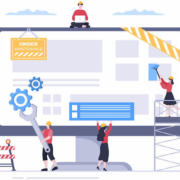Senior Living Website Design: Does Yours Need a Refresh?
As we approach the end of the year, now’s a good time to take stock and plan for 2022. So here’s a question to ponder: Does your senior living website design need a refresh?
To help you decide, ask yourself the following questions:
Is the site older than five years?
Unfortunately, it doesn’t take long for senior living website designs to look dated. (This is true for any design.) While there’s no rule saying that you must redesign, you should take a hard look at the site if it’s older than five years.
If the site is still delivering solid results, you could leave it alone or simply do some cosmetic refreshes here and there. If you go this route, however, you might want to start thinking about a redesign in a year or so—and start planning (and budgeting) for it now.
Was the site professionally designed with search in mind?
Plenty of web designers care primarily about making things look pretty. And while your site’s look-and-feel is important, what’s the point in having an attractive site if it doesn’t come up in organic searches?
Does the site render well across all devices?
And when we say all devices, we mean all: desktops, laptops, tablets, and phones (all of which have various screen sizes). If you’re not sure, run some tests. Look at the site on different devices. Does the site remain easy to navigate and read (a must, especially for your target audience)?
If the answer is no, seriously consider a redesign. A good web developer will create a senior living website design that renders properly across all devices. This will keep users happy as well as Google, which is important from a search perspective. Reminder: Google has publicly said, “We’re boosting the ranking of mobile-friendly pages on mobile search results.”
Is your site accessible to everyone?
Have you heard of the Web Content Accessibility Guidelines (WCAG)? Its goal is to provide “a single shared standard for web content accessibility that meets the needs of individuals, organizations, and governments internationally.”
We’ve always advocated making senior living websites accessible to everyone, especially since our target audience is an older demographic, many of whom have aging eyes. Over the years, we’ve taught many clients about the value of adjustable text sizing, strong color contrast with fonts and backgrounds, avoiding layering text over images, and using alt tags to describe images. (Just to name a few best practices.)
So ask yourself: Is your site accessible to all people? If the answer is no, you need to address this. The solution might not involve a complete gutting of the website. (We can help you with this step, thanks to our collaboration with UserWay, our accessibility compliance partner.)
Is the site delivering results?
Your website serves as your 24/7 sales counselor and as your virtual welcome center. It should absolutely be making you money by attracting the right visitors, turning those visitors into leads, and converting those leads into move-ins.
To achieve these results, your site needs to deliver a fabulous experience at every point in the buyer’s journey. Between the analytics and your own gut, you probably already know the answer to this question. If your site isn’t delivering strong ROI, it’s time to revisit what’s going on—and to make plans for a redesign, if necessary.
Still not sure? Maybe it’s time to perform an audit of your online presence.
Remember, your website is the primary hub of your overall online presence, but all those other online hubs—think social media platforms, Google My Business, and directory listings—need to work in concert with the main hub, your senior living website. So if you haven’t performed an audit of your overall online presence in the last couple of years (or ever), then that’s a good first step.
The audit will automatically answer all of the above questions. You can do the audit yourself. Or you can order a budget-friendly audit from us. We provide a fresh set of eyes and objective assessment—along with a concrete plan for making fixes that your team can run with. Learn more about our Total Online Presence Audit here. And, as always, reach out if you have questions.












